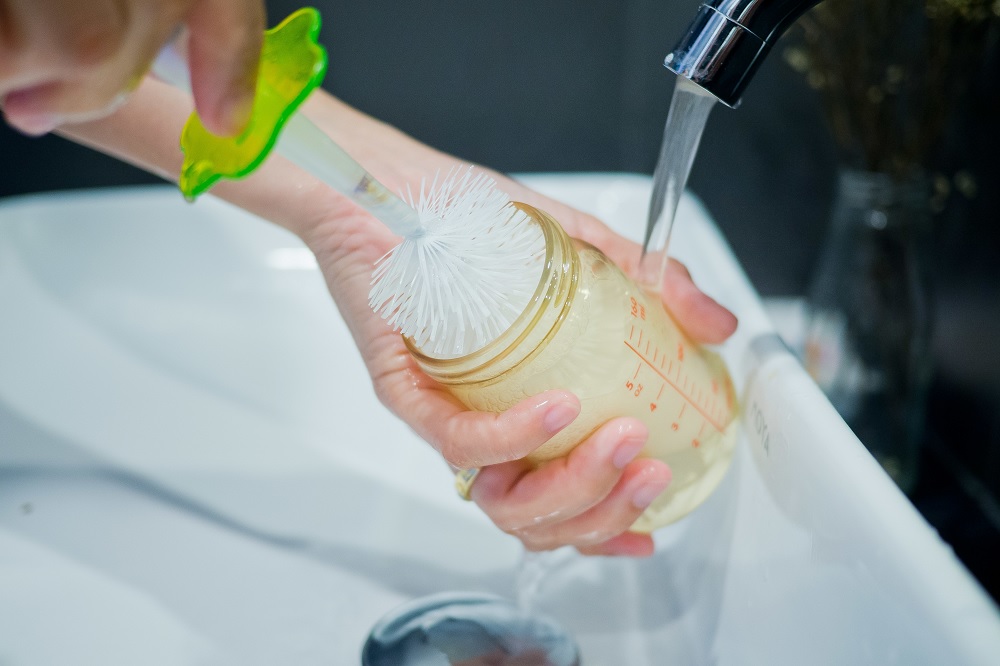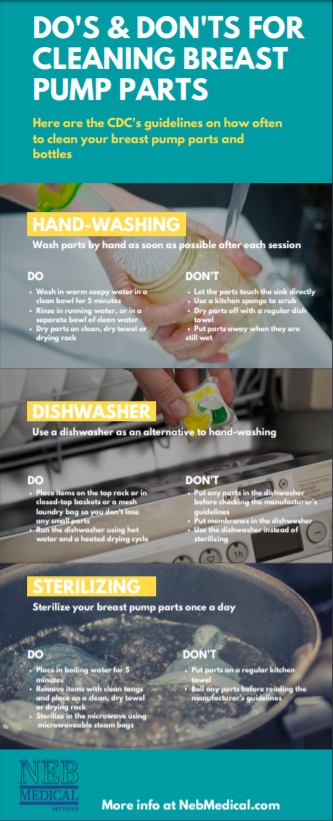Often the biggest headache for moms who are breast pumping, isn’t the pumping itself – it’s the hassle of having to clean all of the breast pump parts and accessories. All. The. Time.
And, unfortunately, even though it may seem like a pain to clean all of those parts after each session, it’s important to clean breast pumps properly, because if you don’t, you may expose your baby to dangerous germs, which can lead to serious (and even deadly) infections. And in the age of COVID-19, it’s more important than ever to clean all breast pump parts and accessories to avoid passing any germs on to your baby.
In May 2019, the CDC updated its recommendations about how often to clean your breast pump parts. They now suggest that you wash your hands thoroughly (using soapy water for 20 seconds) before you begin any breast pumping session, and then wash any bottles and breast pump parts that come into contact with breast milk as soon as possible after each session. Finally, they suggest that you sterilize all bottles and breast pump parts once a day.
If you don’t have time to clean all of your parts after each use while you’re at work, one of the easiest solutions is to purchase multiple parts so you can just clean everything when you get home from work. It may be a bit expensive, but it will definitely save time!
Here are a few do’s and don’ts for washing and sterilizing breast pump parts:
Do’s and Don’ts for Hand-Washing Breast Pump Parts
After each pumping session, it’s important to wash all breast pump parts and bottles as soon as possible. You can do this either by hand-washing the parts, or by putting them in the dishwasher, depending on the manufacturer’s recommendations. Here’s what to keep in mind if you are hand washing your parts.
Do:
- Fill a large, clean bowl or wash basin (that is specifically used for breast pump parts), with warm soapy water. Swoosh your parts around in the water for 5 minutes.
- If necessary, use a bottle brush to scrub small parts.
- Rinse in running water, or in a separate bowl of clean water.
- Afterwards, take the parts out and place them on a clean, dry towel or drying rack to air dry.
Don’t:
- Let the parts touch the sink directly. There are lots of germs in the sink!
- Use a kitchen sponge to scrub the parts.
- Dry parts off with a regular dish towel.
- Put parts away when they are still wet. This can cause mold.
Do’s and Don’ts for Putting Breast Pump Parts in the Dishwasher
If you don’t want to hand-wash your parts, you can also clean some parts in a dishwasher. However, check your specific pump’s manufacturer recommendations before placing any parts in the dishwasher. Spectra USA, for example, says that while you can wash some of their parts in the dishwasher, they recommend using it only sparingly, because putting parts in the microwave or dishwasher causes them to deteriorate faster.
Here’s what to keep in mind if you are cleaning your parts in the dishwasher:
Do:
- Place items on the top rack or in closed-top baskets or a mesh laundry bag so you don’t lose any small parts.
- Run the dishwasher using hot water and a heated drying cycle.
Don’t:
- Put membranes in the dishwasher. They are too delicate.
Do’s and Don’ts for Sterilizing Breast Pump Parts
At the end of the day, it’s a good idea to take the extra time to sterilize your breast pump parts. You can do this one of three ways: by boiling the parts, putting them in sterilizing bags in the microwave, or running your dishwasher on a sterilizing setting.
To boil, place the parts in a pot and cover with water. Bring the water to a boil and boil for 5 minutes. Remove items with clean tongs and place on a clean, dry towel or drying rack.
To steam, you can use microwaveable steam bags — such as the Quick Clean Micro-Steam Bags from Medela from Ardo or others. Just place the items in the bag, add some water, and zap them for 5 minutes or less to kill off any germs or bacteria that have gotten on the parts.
A Note About Tubing
You don’t need to wash your tubes because they do not come into contact with milk. But if you start to notice milk or mold in your tubing, throw it away and buy new tubes.



